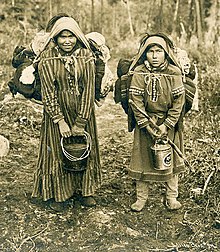
Chief Stickwan's two daughters holding buckets and carrying burdens on backs with trump lines, Klutina-Copper Center band of Lower Ahtna, 1903.
The Ahtna (also Ahtena, Atna, Ahtna-kohtaene, or Copper River) are an Alaska Native Athabaskan people of the Athabaskan-speaking ethnolinguistic group. The people's homeland called Atna Nenn', is located in the Copper River area of southern Alaska, and the name Ahtna derives from the local name for the Copper River. The total population of Ahtna is estimated at around 500.
The name Ahtena, also written as Ahtna and Atnatana, translates as "ice people." In some documentation the Ahtna have been called Copper Indians because of their ancestral homeland located in the basin of the Copper River and its tributaries in southeastern Alaska. The word for the Copper River in Ahtna is 'Atna' tuu" (tuu meaning water). Thus, "Ahtna" refers to the People of the 'Atna' River (i.e. The Copper River). The named Yellowknife has also been used in reference to the Ahtna's copper-colored knives; however, another tribe, the Yellowknives, are also referred to as Copper Indians.
Traditionally, the Ahtna shared social structure traits similar to those Indigenous peoples of the Pacific Northwest Coast. Social stratification was represented in the governance of the community. Each village was ruled by a chief or tyone. Subchiefs, called skilles, served as council and helped to oversee the common people and servant class. Shamans also had political power and oversaw potlatch celebrations.
CIB
Kin 36: Yellow Planetary Warrior
I perfect in order to question
Producing fearlessness
I seal the output of intelligence
With the planetary tone of manifestation
I am guided by the power of flowering.
Resonance is the underlying structure of unification.*
*Star Traveler's 13 Moon Almanac of Synchronicity, Galactic Research Institute, Law of Time Press, Ashland, Oregon, 2015-2016.
The Sacred Tzolk'in
Sahasrara Chakra (Dali Plasma)




No comments:
Post a Comment